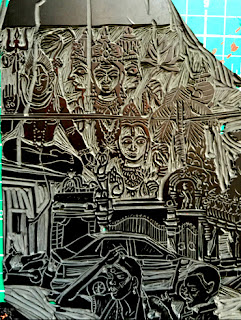Throughout the duration of this project I have been taking
on self initiated and self selected briefs which have all shown a keen interest
in colour, line work and mark making, pattern and people. This has been through
a broad range of mediums from print making to editorial illustrations. I have
found my most enjoyable and most successful pieces to be those which combine
research to form content with detailed and careful production methods, while
still keeping a freedom to work into the work spontaneously. I think this last
point is what I enjoy most about art and the reason I chose to study
illustration - the expression and the freedom in art. However this also is
probably why the majority of my briefs were self initiated, collaborative or
individual client based, all of which where there is some creative freedom. I
loved working collaboratively and on a personal level with people. These were
the briefs which I felt most invested in.
I found the blog very useful in keeping on top of all the
briefs which were happening simultaneously, and I also found text playing a
large roll in my briefs such as the Q&A Saturday brief. Concerning my
Statement of Intent, my final major project reflects these themes of people,
research, line work and mark making. The time spent researching gave me the
freedom to create a scene which still had relevance to the Indian culture and
my own experiences there. Lino was the perfect medium for me to work with as it
was very practical and allowed me to really investigate into mark making and
manipulating tools and the lino to create the image and shapes I wanted. The
last three years have taught me about the power of using media and processes to
capture the character or mood of a piece. Through lino cut I have not allowed
myself to be a perfectionist with people and objects. I am also using a tool
which sometimes is hard to control but this has been a great thing for my
practice because with its restraints, lino printing gave me a freedom to
explore the process driven mark making and line work.

















































